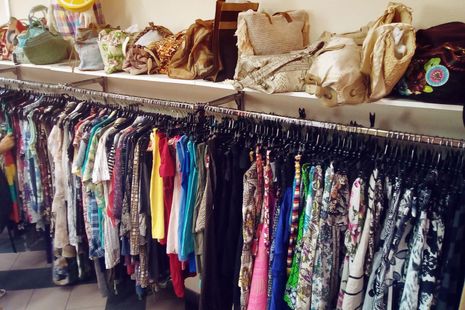Has the rise of the reseller killed the charity shop?
Resellers alone are not driving the rise in prices and poor-quality donations in charity shops but they are a symptom of the wider issues of overconsumption and fast fashion, argues Elsie McDowell

“Super cute stunning y2k vintage fairycore maxi dress.” Anyone who has spent time on second-hand clothing apps like Vinted and Depop will have seen numerous posts like this from reseller accounts. Unlike those dimly lit photos of someone’s old prom dress laid out on their bed, these accounts feature clear, glitzy thumbnails often showcasing items on a “model” or mannequin. They use buzzwords like “y2k” and “vintage” and offer hundreds of similarly styled clothes. As second-hand fashion has boomed, have resellers championed sustainability or contributed to rising prices in charity shops and on second-hand clothing apps?
“Second-hand resale apps are increasingly centred on ease of selling rather than buying”
Firstly, it’s important to explore why clothes from resellers are more expensive. Like brick-and-mortar vintage or antique shops – or even boutique charity shops – you’re paying a premium for curation. Rather than sifting through piles of tacky t-shirts, buying from a reseller means you can choose from a carefully selected collection of trending clothes.
Equally, second-hand resale apps are increasingly centred on ease of selling rather than buying. Vinted was the first to remove mandatory sales fees for sellers, shifting these costs to buyers through the “buyer protection fee”. This year, both Depop and eBay (albeit just for clothing) have adopted this model. This shift indicates that these apps target consumers willing to endure higher prices and sellers aiming to maximise the volume of their listings.
This trend reflects a broader change in what the purpose of second-hand clothing is understood to be. Twenty years ago, charity shops were the cheapest place to find clothes, primarily serving those who couldn’t afford them elsewhere. Today, the low prices of ultra-fast fashion brands like Shein, coupled with the trendiness of second-hand clothing, have made second-hand shopping increasingly popular among the sustainability-conscious middle class.
“It’s understandable that charity shops have capitalised on the second-hand fashion surge”
But what about charity shops? Some argue that online resellers drive up prices in charity shops, making them inaccessible to those who need them most. However, the primary goal of charity shops is to raise money for the organisations they represent, not necessarily to provide the cheapest clothing – even if, historically, low-income households have relied on them the most.
It’s understandable that charity shops have capitalised on the second-hand fashion surge by using more sophisticated – and standardised – pricing systems. Charity shop prices are now much higher in wealthy areas to take into account their more affluent consumer base and the ease of reverse image searches and second-hand fashion apps makes it much easier for charity shops to gauge what shoppers are willing to pay. Like all retailers, charity shops are also facing higher expenditures; the 2023 Charity Shops Survey found that expenditures among charity shops were 14% higher than the year before.
The point is, charity shops are becoming more expensive – the Charity Retail Association reported that, between 2022 and 2023, the average value of a transaction in a charity shop rose from £6.65 to £7.02 – but resellers alone are not responsible for this. Online resellers are part of a wider issue: the “fast-fashionification” of second-hand clothing.
“If you don’t think it will sell on Depop, it probably won’t sell in a charity shop either”
Increasingly, charity shops are serving as dumping grounds for clothes unlikely to sell on platforms like Vinted, particularly ultra-fast fashion items. But, if you don’t think it will sell on Depop, it probably won’t sell in a charity shop either. Consequently, charity shops have reported a rise in low-quality donations that often end up in landfills anyway, typically in the Global South.
Some suggest that resellers help mitigate this by purchasing large amounts of charity shop stock, with resellers working to increase the meagre rate of 10-30% of donated clothes being sold. But, in practice, resellers are buying trendy or high-quality clothes that probably would have sold anyway. Resellers are a symptom, not a cause, of the wider issue at hand: overconsumption.
In theory, buying second-hand clothes offers a way to enjoy fast fashion without its environmental impact. However, second-hand clothing is not immune from the poor quality and short life-cycles characteristic of fast fashion, nor does it truly challenge overconsumption.
Second-hand fashion has become trendy and both online resellers and charity shops are capitalising on this. In the process, however, the group of people who once relied on charity shops out of necessity have been sidelined in favour of more affluent consumers. Resellers may not have killed the charity shop but they, along with the apps they use, have entirely changed who second-hand fashion is for.
 News / Cambridge student numbers fall amid nationwide decline14 April 2025
News / Cambridge student numbers fall amid nationwide decline14 April 2025 News / Greenwich House occupiers miss deadline to respond to University legal action15 April 2025
News / Greenwich House occupiers miss deadline to respond to University legal action15 April 2025 Comment / The Cambridge workload prioritises quantity over quality 16 April 2025
Comment / The Cambridge workload prioritises quantity over quality 16 April 2025 Sport / Cambridge celebrate clean sweep at Boat Race 202514 April 2025
Sport / Cambridge celebrate clean sweep at Boat Race 202514 April 2025 Features / The TikTok college: using social media in access and outreach15 April 2025
Features / The TikTok college: using social media in access and outreach15 April 2025






